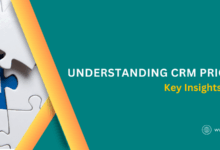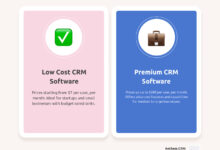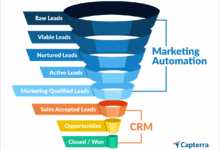Salesforce CRM Cost: Understanding Pricing, Customization, And Savings
Salesforce CRM cost sets the stage for this enthralling narrative, offering readers a glimpse into a story that is rich in detail and brimming with originality from the outset. The various cost components, subscription plans, customization options, and hidden costs associated with Salesforce CRM will be explored in depth, providing valuable insights for businesses looking to optimize their CRM investment.
Overview of Salesforce CRM Cost
When considering the cost of Salesforce CRM, it is essential to understand the different components that contribute to the overall pricing. These components include subscription fees, customization costs, add-on features, and support services.
Pricing Plans Structure
- Salesforce CRM offers various pricing plans tailored to different business needs, such as Essentials, Professional, Enterprise, and Unlimited editions.
- Each pricing plan comes with different features and capabilities, with pricing based on the number of users and level of functionality required.
- Customers can choose between monthly or annual subscription plans, providing flexibility in payment options.
Comparison with Other CRM Software Options
- Salesforce CRM pricing is known to be on the higher end compared to other CRM software options in the market.
- However, the robust features, scalability, and customization options offered by Salesforce CRM justify the higher cost for many businesses.
- Some CRM software may offer lower initial costs, but they may lack the advanced functionalities and integrations provided by Salesforce CRM.
Subscription Plans
When it comes to Salesforce CRM, there are several subscription plans available to cater to different business needs. Each plan comes with its own set of features and pricing, so it’s important to understand what each plan offers before making a decision.
Enterprise Plan
The Enterprise Plan is tailored for medium to large businesses looking for advanced CRM capabilities. It includes features such as lead scoring, workflow automation, and advanced reporting tools. This plan is ideal for organizations that require a high level of customization and integration with other systems. The cost of the Enterprise Plan can vary based on the number of users and additional add-ons.
Professional Plan
The Professional Plan is designed for small to medium-sized businesses that need essential CRM functionalities. It includes features like contact management, opportunity tracking, and basic reporting. This plan is a more affordable option compared to the Enterprise Plan but still provides key tools to streamline sales and marketing processes.
Essential Plan
The Essential Plan is the most basic option offered by Salesforce CRM. It includes fundamental CRM features such as contact management, task and event tracking, and mobile access. This plan is suitable for startups and small businesses looking to establish a foundational CRM system without investing in advanced features.
Additional Costs
In addition to the subscription plans, there may be additional costs associated with Salesforce CRM. These can include add-on features like Einstein AI, Marketing Cloud, or Service Cloud, which provide enhanced functionalities but come at an extra cost. Implementation and training services may also incur additional charges depending on the level of support required.
Customization Costs
Customizing Salesforce CRM to meet specific business needs can incur additional costs beyond the standard subscription fees. These customization costs are essential for tailoring the CRM system to align with the unique processes and requirements of a company.
Types of Customization and Associated Costs
Customization options in Salesforce CRM can range from simple configurations to complex integrations and development work. Here are some examples of customization options and their associated costs:
- Custom Fields: Adding custom fields to capture unique data points can cost around $500 to $1,000 per field. This cost includes configuration, testing, and training.
- Workflow Automation: Designing and implementing custom workflows to automate business processes can range from $1,000 to $5,000 depending on the complexity of the workflows.
- Integration with Third-Party Apps: Integrating Salesforce CRM with other applications or systems can cost between $2,000 to $10,000 or more, depending on the number of systems and the level of integration required.
- Custom Reports and Dashboards: Creating custom reports and dashboards to visualize data in a specific way can range from $500 to $2,000 per report/dashboard.
- Custom Development: Building custom functionalities or applications within Salesforce CRM can cost anywhere from $5,000 to $50,000 or more, depending on the complexity of the development work.
Implementation Costs
When considering implementing Salesforce CRM, it’s important to factor in the upfront costs involved in the process. These costs can vary depending on a variety of factors, so it’s essential to understand what influences them and how to minimize them.
Factors Influencing Implementation Costs
- The size and scope of your organization: Larger organizations with more complex needs may incur higher implementation costs due to the customization required.
- Integration requirements: If you need Salesforce CRM to integrate with existing systems or third-party applications, this can increase costs.
- Data migration: The cost of migrating your existing data into Salesforce CRM can vary based on the volume and complexity of the data.
- User training: Training your staff to use Salesforce CRM effectively can add to the implementation costs.
Tips to Minimize Implementation Costs
- Plan ahead: Define your requirements and objectives clearly to avoid unnecessary customization and changes later on.
- Choose the right implementation partner: Select a reputable partner with experience in Salesforce CRM implementation to ensure a smooth and cost-effective process.
- Utilize out-of-the-box features: Leverage standard features and configurations provided by Salesforce to reduce the need for extensive customization.
- Train a core team: Instead of training all users at once, focus on training a core team initially who can then train others, minimizing training costs.
Training and Support Costs
Training employees to effectively use Salesforce CRM is essential for maximizing the benefits of the system. There are costs associated with providing this training, as well as ongoing support to ensure smooth operation.
Training Options and Costs
- On-site Training: In-person training sessions conducted at your company’s location can range from $1,000 to $5,000 per day, depending on the trainer’s expertise and the complexity of the training.
- Virtual Training: Online training programs are available at a cost of approximately $50 to $200 per user, depending on the duration and depth of the training.
- Self-paced Learning: Some companies opt for self-paced learning modules, which can cost around $20 to $100 per module, depending on the content and provider.
Ongoing Support Costs
- Standard Support: Salesforce offers standard support as part of the subscription package, which includes access to online resources, knowledge base, and community forums. Additional support can be purchased at an extra cost, typically ranging from $25 to $50 per user per month.
- Premium Support: For more personalized and expedited support, companies can opt for premium support services, which can cost around $100 to $300 per user per month, depending on the level of support required.
- Custom Support: In some cases, companies may require custom support tailored to their specific needs. Costs for custom support can vary widely based on the scope and complexity of the support required.
Integration Costs
Integrating Salesforce CRM with other software systems can incur additional costs that need to be considered when budgeting for your CRM implementation. These costs can vary depending on the complexity of the integration and the systems involved.
Challenges and Expenses
Integrating Salesforce CRM with other software systems can present various challenges and expenses. Some of the common challenges include compatibility issues, data migration complexities, and the need for custom development work. These challenges can lead to increased expenses in terms of time and resources required to successfully integrate the systems.
Common Integrations and Costs
- Integration with marketing automation platforms like HubSpot or Marketo can range from $5,000 to $20,000 depending on the extent of customization and data mapping required.
- Integrating Salesforce CRM with accounting software such as QuickBooks or Xero may cost between $2,000 to $10,000, depending on the complexity of financial data syncing and reporting needs.
- Connecting Salesforce CRM with e-commerce platforms like Shopify or Magento could range from $3,000 to $15,000, considering the level of order processing automation and inventory management required.
Maintenance Costs
When using Salesforce CRM, ongoing maintenance costs are an important consideration to ensure the system runs smoothly and effectively. These costs can vary based on usage levels and the extent of customization within the platform.
Factors Influencing Maintenance Costs
- Regular Updates: Salesforce regularly releases updates to enhance functionality and security. Staying current with these updates can help prevent issues and ensure optimal performance.
- Data Management: Efficient data management practices can reduce the risk of data errors or inconsistencies, ultimately saving time and resources.
- User Training: Investing in continuous user training can increase user adoption and proficiency, leading to fewer support requests and potential issues.
- Customization: Extensive customization of the Salesforce platform may require more ongoing maintenance to address any bugs or conflicts that arise.
Optimizing Maintenance Costs
- Regular Audits: Conduct regular audits of your Salesforce instance to identify any areas for optimization or potential issues before they escalate.
- Automated Processes: Implementing automation where possible can streamline workflows and reduce the need for manual intervention, saving time and resources.
- Proactive Support: Utilize Salesforce support services to address any issues promptly and prevent them from impacting your operations.
- Performance Monitoring: Monitor system performance metrics to proactively address any performance issues and ensure optimal system operation.
Hidden Costs
When budgeting for Salesforce CRM, it is important for organizations to consider potential hidden costs that may not be immediately apparent. These hidden costs can impact the overall investment and should be uncovered and accounted for to avoid any surprises down the line.
Customization Overages
Customizing Salesforce CRM to meet specific business needs is common, but organizations may overlook the costs associated with customization overages. These additional costs can arise if the initial scope of customization exceeds the allocated budget. It is essential to closely monitor customization efforts to prevent overages and stay within budget.
- Custom development work beyond the agreed-upon scope
- Additional hours spent on configuration and customization
- Integration costs with third-party applications
Data Migration Costs
Data migration is a crucial step when implementing Salesforce CRM, but organizations may underestimate the complexity and costs involved. Transferring data from legacy systems, cleaning up data, and ensuring data accuracy can incur unexpected expenses. It is essential to allocate resources and budget for data migration to avoid delays and additional costs during the implementation process.
- Data cleansing and deduplication efforts
- Data mapping and migration tools or services
- Data quality assessment and validation
Additional User Licenses
As organizations grow and expand, the need for additional user licenses for Salesforce CRM may arise. This can result in unforeseen costs if not properly anticipated. It is essential to plan for scalability and account for potential increases in user licenses to accommodate future growth.
- Cost of additional user licenses
- Training and onboarding expenses for new users
- Support and maintenance costs for additional users
Cost Savings and ROI
Organizations looking to implement Salesforce CRM can benefit from calculating the return on investment (ROI) to understand the financial impact of this decision. By analyzing the costs involved and the potential benefits, businesses can make informed decisions regarding Salesforce CRM implementation.
Calculating ROI
- Calculate the initial investment, including subscription, customization, implementation, training, and support costs.
- Estimate the expected benefits such as increased productivity, improved customer satisfaction, and higher sales revenue.
- Determine the payback period by dividing the net benefits by the annual costs to see how long it will take to recoup the investment.
- Consider intangible benefits like enhanced decision-making and data-driven insights.
- Regularly review and update the ROI calculations to track the actual results and adjust strategies accordingly.
Maximizing Cost Savings and ROI
- Opt for a phased implementation approach to minimize upfront costs and demonstrate ROI incrementally.
- Utilize Salesforce’s automation features to streamline processes and reduce manual efforts, leading to cost savings.
- Regularly train employees to maximize system utilization and ensure a high ROI on the investment.
- Leverage Salesforce’s analytics and reporting capabilities to identify areas for improvement and optimize operations.
Success Stories
- A manufacturing company increased its sales by 30% and reduced customer service response times by 50% after implementing Salesforce CRM.
- A financial services firm saved $100,000 annually by automating manual processes and improving data accuracy with Salesforce CRM.
- A healthcare organization achieved a 25% reduction in patient wait times and a 20% increase in patient satisfaction scores with Salesforce CRM.
Tips for Cost Optimization
When it comes to optimizing costs while using Salesforce CRM, there are several strategies you can implement to get the most out of your investment. By following these best practices, you can effectively manage and reduce the overall costs associated with Salesforce CRM.
Leverage Standard Features and Functionality
- Maximize the use of standard features and functionality provided by Salesforce CRM before opting for customizations, as customization costs can add up quickly.
- Regularly review and optimize your workflows and processes to ensure you are utilizing the CRM efficiently and effectively.
Train and Educate Users
- Invest in training and education for your users to ensure they are proficient in using Salesforce CRM, reducing the need for additional support and training costs in the long run.
- Encourage continuous learning and adoption of best practices to maximize the benefits of the CRM system.
Monitor and Analyze Usage
- Regularly monitor and analyze your usage data to identify areas where you can optimize and streamline processes to reduce costs.
- Use reporting and analytics tools within Salesforce CRM to track key metrics and KPIs to make informed decisions about cost-saving opportunities.
Explore Integration Options
- Consider integrating Salesforce CRM with other business tools and applications to streamline processes and improve efficiency, potentially reducing the need for manual tasks and associated costs.
- Choose integration solutions that are cost-effective and add value to your overall CRM strategy.
Closing Notes
In conclusion, navigating the costs of Salesforce CRM requires a comprehensive understanding of pricing structures, customization expenses, and potential savings. By following the tips provided and being aware of hidden costs, organizations can make informed decisions to maximize their ROI with Salesforce CRM.


